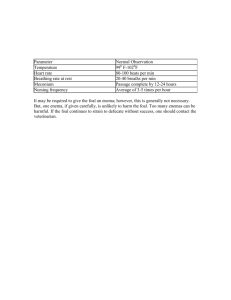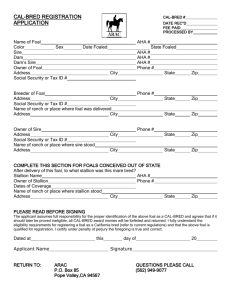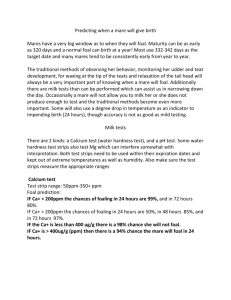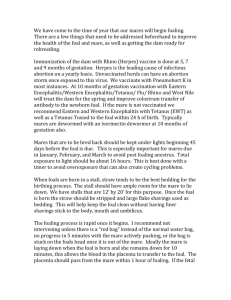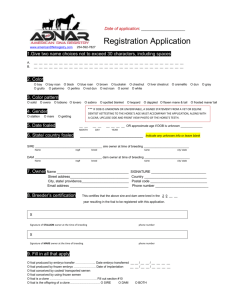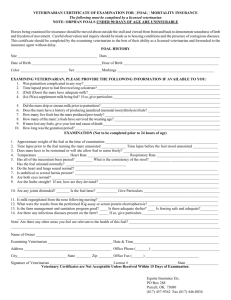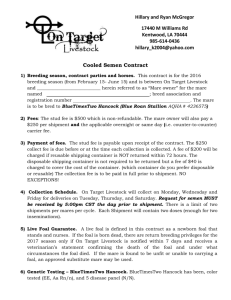A Foal Is Born (Word 49KB) - Literacy Online
advertisement
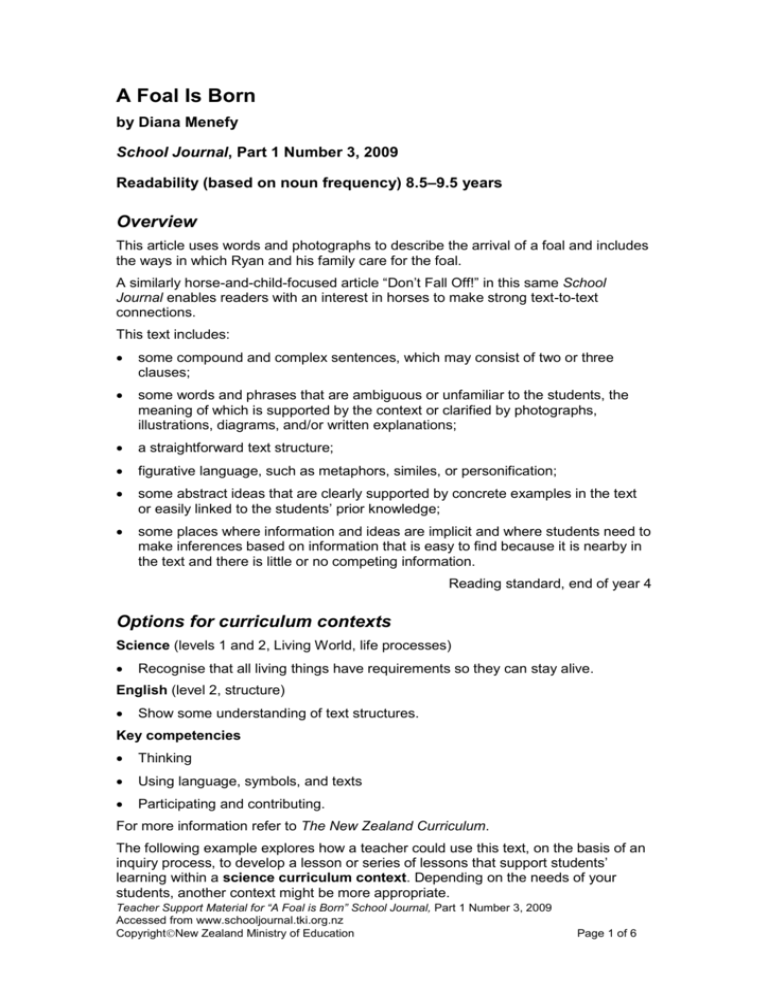
A Foal Is Born by Diana Menefy School Journal, Part 1 Number 3, 2009 Readability (based on noun frequency) 8.5–9.5 years Overview This article uses words and photographs to describe the arrival of a foal and includes the ways in which Ryan and his family care for the foal. A similarly horse-and-child-focused article “Don’t Fall Off!” in this same School Journal enables readers with an interest in horses to make strong text-to-text connections. This text includes: some compound and complex sentences, which may consist of two or three clauses; some words and phrases that are ambiguous or unfamiliar to the students, the meaning of which is supported by the context or clarified by photographs, illustrations, diagrams, and/or written explanations; a straightforward text structure; figurative language, such as metaphors, similes, or personification; some abstract ideas that are clearly supported by concrete examples in the text or easily linked to the students’ prior knowledge; some places where information and ideas are implicit and where students need to make inferences based on information that is easy to find because it is nearby in the text and there is little or no competing information. Reading standard, end of year 4 Options for curriculum contexts Science (levels 1 and 2, Living World, life processes) Recognise that all living things have requirements so they can stay alive. English (level 2, structure) Show some understanding of text structures. Key competencies Thinking Using language, symbols, and texts Participating and contributing. For more information refer to The New Zealand Curriculum. The following example explores how a teacher could use this text, on the basis of an inquiry process, to develop a lesson or series of lessons that support students’ learning within a science curriculum context. Depending on the needs of your students, another context might be more appropriate. Teacher Support Material for “A Foal is Born” School Journal, Part 1 Number 3, 2009 Accessed from www.schooljournal.tki.org.nz CopyrightNew Zealand Ministry of Education Page 1 of 6 Suggested reading purpose To learn about looking after a newborn foal Links to the National Standards and the Literacy Learning Progressions Your students are working towards the reading standard for the end of year 4. By the end of year 4, students will read, respond to, and think critically about texts in order to meet the reading demands of the New Zealand Curriculum at level 2. Students will locate and evaluate information and ideas within texts appropriate to this level as they generate and answer questions to meet specific learning purposes across the curriculum. Reading standard, end of year 4 Students can: meet their purposes for reading by employing specific comprehension strategies, such as: o identifying and summarising main ideas (using their knowledge of text structure) o making and justifying inferences (using information that is close by in the text) o making connections between the text and their prior knowledge to interpret figurative language; use visual language features to support their understanding of the ideas and information in the text. Reading progressions, end of year 4 Key vocabulary Words and phrases, including “foal”, “paddock”, “filly”, “binoculars”, “sac”, “farrier”, “leading rope”, “hands”, “stethoscope”, “antibodies”, “substances”, “infections”, “bay mare”, “mane” The language of sequence: “The next morning”, “While”, “Soon”, “When”, “Now”, “Next day”, “Then”. Refer to Sounds and Words (http://soundsandwords.tki.org.nz) for more information on phonological awareness and spelling. Prior knowledge Prior knowledge that will support the use of this text is: personal experiences: o riding or looking after horses o caring for other pets or animals, especially when they are babies topic knowledge: horses and their relationships with humans (the need to become familiar with humans from a young age, use of a leading rope, horseshoes) Teacher Support Material for “A Foal is Born” School Journal, Part 1 Number 3, 2009 Accessed from www.schooljournal.tki.org.nz CopyrightNew Zealand Ministry of Education Page 2 of 6 literacy-related knowledge: using photographs and words together to understand a text. Features of the text These features may support or challenge the students depending on their prior knowledge. The inclusion of a glossary for technical words The use of dialogue within the recount, which gives immediacy and supports identification with the people in the article The supportive photographs The opportunities to make inferences based on information that is easy to find, for example, eleven months’ gestation; the foal has to stand up quite quickly after birth to feed; the foal feeds by drinking from her mother; getting the foal used to being touched The use of some compound and complex sentences of two or more clauses – “Ryan held up the measuring stick, but Dosti decided she didn’t like the look of it, and she wouldn’t stand still.” The comparisons with human babies (for example, human babies don’t stand and walk until they are about one year old), including their need for care and attention The parallel between the vet’s visit and the medical check-ups human babies have The use of the apostrophe for possession and contraction – “mum’s”, “It’ll”, “It’s”, “She’s”, “That’s”, “Ryan’s”, “foal’s”, “What’s”, “Dosti’s”, “didn’t”, “She’ll” The unfamiliar meaning of “hand” as a unit of measurement The term “a leading rope”. Suggested learning goal To find and summarise key information about caring for a newborn foal Success criteria To support our understanding of the text, we will: ask questions about foals and looking after foals identify keywords use photos and keywords to identify important information make connections with our own lives. A framework for the lesson How will I help my students to achieve the learning goal? Preparation for reading English language learners Teacher Support Material for “A Foal is Born” School Journal, Part 1 Number 3, 2009 Accessed from www.schooljournal.tki.org.nz CopyrightNew Zealand Ministry of Education Page 3 of 6 Remember that English language learners need to encounter new vocabulary: many times; before, during, and after reading a text; and in the different contexts of reading, writing, speaking, and listening. You will need to decide on the specific vocabulary and language structures that are the most appropriate in relation to the purpose for reading and explore these with your students before they read the text. Scaffold the students’ understanding of the context by providing some background to the text and any necessary prior knowledge. Also support the students with some pre-reading experiences, such as jigsaw reading, partner reading, or specific activities to explore and develop vocabulary. For more information and support with English language learners, see ESOL Online at www.esolonline.tki.org.nz Before reading Share the purpose for reading and briefly introduce the article. Discuss experiences the students may have had with animals giving birth and support them to make connections with pets, animals, and babies in the family. “I wonder what things all baby animals need to survive?” Share the purpose for reading, the learning goal, and the success criteria with the students. Reading and discussing the text Refer to Effective Literacy Practice in Years 1 to 4 for information about deliberate acts of teaching. Page 9 Introduce the title and discuss what a foal is. Model the strategy of asking questions: “When I’m starting to read an article, I think about the questions the title brings up for me. For example, I wonder where this is set? Or whose horse it is.” Record questions that the students generate in a modelling book or on a whiteboard. Read the page, then think about questions. “What questions does this page make you think of?” If necessary, model a question such as: “I’m wondering how long it takes for a mother horse to produce a baby.” “How does Ryan’s mum know it will be born any day now?” (She knows how long a foal takes to grow in the mother; knows signs the mother is ready to give birth.) “How did she know to go to the paddock in the night?” Remind the students to look for the answers to their questions as they read. Prompt the students to make connections with what they know about animals that give birth to babies (mammals). “How long do the babies take to grow?” Page 10 Confirm any unfamiliar words such as “filly” (female foal) if you haven’t already gone through the glossary. “Why couldn’t Ryan stroke the foal?” (One of the important requirements for newborn animals is bonding with the mother.) “I wonder why the foal has got that white thing on its head? What might it be?” Refer the students to the text to confirm that it is the sac in the photo. Encourage the students to make connections with human babies and what happens when they are born (often born in hospital; they have a sac too; they need to bond with their mother; they don’t stand up for a long time). Teacher Support Material for “A Foal is Born” School Journal, Part 1 Number 3, 2009 Accessed from www.schooljournal.tki.org.nz CopyrightNew Zealand Ministry of Education Page 4 of 6 Page 11 Encourage the students to find keywords that will lead them to identify main ideas about looking after foals. “I’ve noticed that Ryan’s mum helps the mother horse. I wonder why she would need help?” (She has just given birth and is probably tired; she needs to eat and drink because she is feeding a baby now; she needs to look after her baby.) Encourage the students to make connections between “look[ing] for a feed”, “finished drinking from her mother”, and the photo at the top of page 11. (The foal doesn’t eat grass right away. She needs to drink milk from her mother, just the same as other mammal babies.) Note that the foal rests. It’s the same for other babies – they need lots of rest to grow. Page 12 “I wonder why Ryan’s mum is doing all that she does?” (The foal will be with humans a lot, so she has to get used to them quickly.) “Does this happen for other animals? Why/why not? Does this raise any questions for you?” Page 13 Read page 13. Check to see if any of the students’ questions have been answered by this page and record any more that this page generates. For example, “Why is it important for Ryan to come up behind the foal?” “Why did Del let him touch it?” (She knows him, so she can trust him.) “Would it be safe you or me to walk up to a new foal?” (No, it wouldn’t be safe for us if the mare doesn’t know us, because she might try to get us away from her foal.) “What might Ryan be thinking? How is he feeling?” (Excited: he’s been waiting a long time; this might be first time he’s seen a new foal.) “I wonder why the foal was named Dosti? Do all animal babies have names?” Encourage students to make connections with the naming of their own pets. Page 14 “I wonder why they measure the foal?” Discuss the purpose of taking measurements and make connections with human babies (to check for progress as the baby grows – this is important for health). Page 15 Continue prompting the students for connections to their own lives. For example: “Who measures us when we’re born?” (midwife, doctor, Plunket nurse). “I wonder why they do it?” “What happens if there is anything wrong?” Relate the discussion to the requirements for healthy life for humans and animals. Discuss the last sentence and the connections we can make with our own family and family resemblances. After reading Review the purpose for reading. Summarise the key information on looking after foals from your modelling book. Discuss any questions that haven’t been answered and any further questions that arise. Share unanswered questions out and have pairs follow them up, write a Teacher Support Material for “A Foal is Born” School Journal, Part 1 Number 3, 2009 Accessed from www.schooljournal.tki.org.nz CopyrightNew Zealand Ministry of Education Page 5 of 6 paragraph or make notes, and then bring their information back to the group to share. Reflect with the students on how well they have met the learning goal and note any teaching points for future sessions. For example, “How did asking questions help you to better understand the text?” “Is it a problem if the text does not have all the answers?” Further learning What follow-up tasks will help my students to consolidate their new learning? Summarise similarities and differences between human and horse babies, using a graphic organiser (T-chart, Venn diagram). Encourage students to do another comparison themselves, for example, comparing human babies with those of sharks, birds, or whales. Explore different ways of measuring animals, including humans. This can include research about how horses are measured. “Is the relationship between arm span and height in humans similar for horses?” Read the other horse article in this School Journal, “Don’t Fall Off!”, or other horse or baby animal stories, such as “Mice for Sale” (SJ 1.1.07), “Caring for Birds” (SJ 2.4.06), “All I Want for Christmas” (SJ 2.4.09), or “Hundreds of Pets” (SJ 1.3.00). Teacher Support Material for “A Foal is Born” School Journal, Part 1 Number 3, 2009 Accessed from www.schooljournal.tki.org.nz CopyrightNew Zealand Ministry of Education Page 6 of 6
